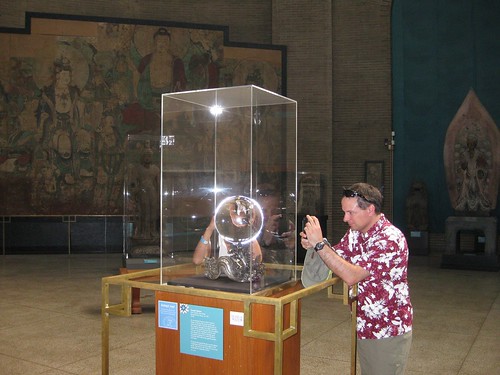 For a higher-quality image– without the display case– take a look here.
Here is what the display placard has to say:
For a higher-quality image– without the display case– take a look here.
Here is what the display placard has to say:
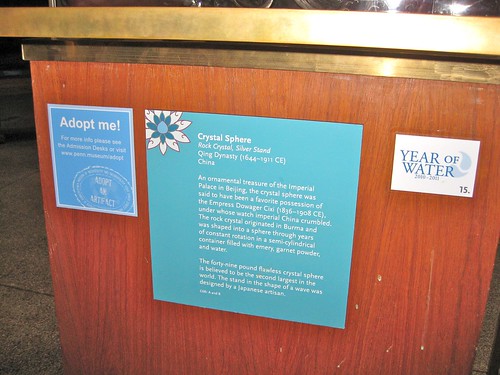
“Crystal Sphere
Rock crystal, Silver Stand
Qing Dynasty (1644-1911 CE)
China
An ornamental treasure of the Imperial palace in Beijing, the crystal sphere was said to have been a favorite possession of the Empress Dowager Cixi (1836 -1908 CE), under whose watch imperial China crumbled. The rock crystal originated in Burma and was shaped into a sphere though years of constant rotation in a semi-cylindrical container filled with emery, garnet powder, and water. The forty-nine pound flawless crystal sphere is believed to be the second largest in the world. The stand in the shape of a wave was designed by a Japanese artisan.”
So, not only is it a giant crystal ball, but it’s a historically interesting giant crystal ball. But besides that– and its brief modern stint as a hat rack –what’s genuinely remarkable about this particular artifact is that it’s made from a chunk of rock crystal, better known as quartz crystal. Now, those “crystal balls” that run-of-the-mill fortune tellers use are often just glass— glorified playground marbles or perhaps so-called lead crystal, which is actually just another type of glass. Quartz crystal, on the other hand, has a structured atomic lattice that leads to some very interesting physical properties including piezoelectricity, triboluminescence, and birefringence. These properties arise from the crystal structure itself; they are typically minimal or absent in glasses such as fused silica (glass made by melting quartz crystal). While the museum probably wouldn’t want you compressing or grinding their crystal ball for piezoelectricity or triboluminescence experiments, the birefringence is boldly sitting out on display. Let’s look a little closer: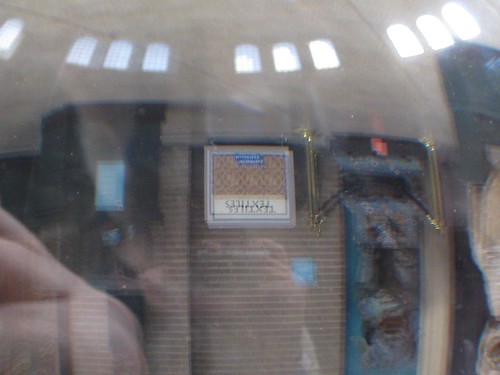 The sign, across the room reading “TEXTILES” is not just inverted like it would be with a spherical lens, but also– plain as day –appears as double image, even through our single camera lens.
Why? Quartz crystal is a birefringent material, which means that light rays entering the material experience two different indices of refraction, depending on their polarization and orientation with respect to the crystal lattice. In practice, our eyes see all polarizations, so this means that the crystal ball acts like a superposition of two glass balls with different indices of refraction– and light rays entering the sphere at any given point can follow two different paths to reach your eyes. Hence the double image.
It’s also worth noting that the two separate images are composed of photons with perpendicular polarization. If you were to look at this sphere through a linear polarizer (e.g., one lens of the 3D glasses that they use in modern movie theaters), you could turn it such that only one of the two images was visible at a time.
The sign, across the room reading “TEXTILES” is not just inverted like it would be with a spherical lens, but also– plain as day –appears as double image, even through our single camera lens.
Why? Quartz crystal is a birefringent material, which means that light rays entering the material experience two different indices of refraction, depending on their polarization and orientation with respect to the crystal lattice. In practice, our eyes see all polarizations, so this means that the crystal ball acts like a superposition of two glass balls with different indices of refraction– and light rays entering the sphere at any given point can follow two different paths to reach your eyes. Hence the double image.
It’s also worth noting that the two separate images are composed of photons with perpendicular polarization. If you were to look at this sphere through a linear polarizer (e.g., one lens of the 3D glasses that they use in modern movie theaters), you could turn it such that only one of the two images was visible at a time.
Birefringence is not particularly rare, and there are materials (like certain forms of calcite) that have huge, easily visible birefringence. Optical devices made from flawless natural calcite, exploiting this property, are tremendously important to scientific research and industry.
We tend to think of a quartz crystal as being perfectly clear– not something that gives you a double image when you look through it. That’s because quartz is only very weakly birefringent, especially when compared to calcite. Quartz is, however, still extensively used in industry in applications for which high transparency and very slight birefringence are key, such as optical wave plates. And, what’s truly remarkable about the Penn Museum sphere is that this tiny property– usually so hard to see –is so plainly visible to the human eye.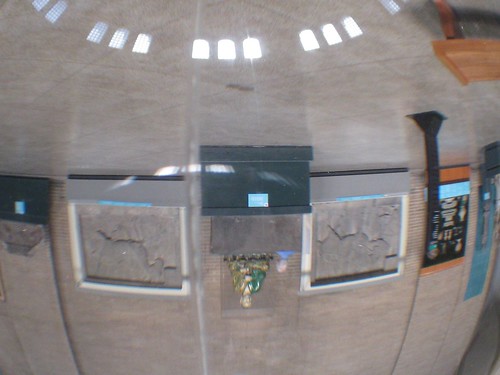 Finally, as we mentioned, the amount of birefringence depends on the orientation of light rays with respect to the crystal itself.
This means that if we walk one quarter circle around the sphere to a point where we’re closer to looking directly along (or perhaps, perpendicular to) the optical axis of the quartz sphere, the image suddenly becomes (if you’ll pardon the pun) crystal clear.
Finally, as we mentioned, the amount of birefringence depends on the orientation of light rays with respect to the crystal itself.
This means that if we walk one quarter circle around the sphere to a point where we’re closer to looking directly along (or perhaps, perpendicular to) the optical axis of the quartz sphere, the image suddenly becomes (if you’ll pardon the pun) crystal clear.




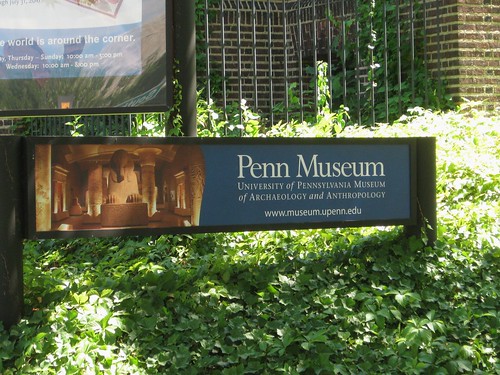
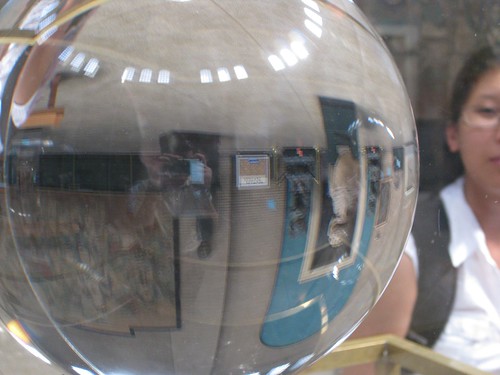
According to a physics class I took, light that reflects off of some surfaces is polarized. This includes light reflected off of cars, which becomes horizontally polarized. This can be observed as glare, and can be reduced with polarized glasses, which are vertically polarized. Some interesting things I noticed while looking through them:
IMAX 3D is vertically polarized in the left lens, and horizontally on the right.
Direct3D glasses have odd polarized properties that I cannot explain (help would be nice).
Reflections of clouds on cars are horizontally polarized.
The Boston Museum of Science has a polarized wall that has an image on it. This image is vertically polarized, with a horizontally polarized negative on top to make the wall seem white without a lens. With polarized sunglasses, I didn’t have to wait in line.
The tinted windows in cars seem to have a hexagonal grid of polarized circles when viewed under some lighting.
Most LCD displays are diagonally polarized. GPS systems should use vertically polarized screens to improve visibility for those using polarized glasses.
Hopefully, I’m not the only one who found all that interesting.
I’m only aware of the programming API for Microsoft with the term “Direct 3D”, though perhaps what you’re looking for is ‘circular polarization’. This is a quite strange concept (“how can it turn, there are no moving parts in the glasses?”) which is explained in Wikipedia.
Real-D, the 3D technology used in most cinemas these days, use circular polarized light, not linearly polarized light.
Interesting; I haven’t been to a theater that uses that type.
Windell H. Oskay
drwho(at)evilmadscientist.com
http://www.evilmadscientist.com/
Circular polarizers were used for some antireflective displays. Light going in is polarized in one orientation (either left-hand or right-hand circularly polarized), and is reversed on reflection such that it is blocked when going back through the polarizer.
As for reflected light being polarized, look up "Brewster Angle":
http://en.wikipedia.org/wiki/Brewster_angle
Dave
> […] As for reflected light being polarized, look up "Brewster Angle":
I find your assumptions about my lack of knowledge amusing. :)
Windell H. Oskay
drwho(at)evilmadscientist.com
http://www.evilmadscientist.com/
That awesome closeup of the ‘textiles’ sign is very difficult to look at. It actually hurts my eyes! ;)
Ok, First apologies for the long post – but this is from a Fresh Air transcript with Dave Davies and art theft investigator Robert Whitman concerning the theft of this Sphere – I couldn’t find a link to just this part so I cut and pasted. (whole link http://www.wbur.org/npr/137393980/robert-wittmans-priceless-pursuit-of-stolen-art )
DAVIES: Let’s talk about one of the cases that you solved and that you write about in the book, a couple of items taken from the Antiquities Museum at the University of Pennsylvania: one Egyptian, one Chinese. Tell us about what was missing.
Mr. WITTMAN: Yeah. The Chinese piece was a wonderful crystal ball. It’s the second-largest crystal ball in the world. The only one that’s bigger is at the Smithsonian in Washington, D.C. This particular one weighed more than 50 pounds. It’s a perfect crystal, perfectly round sphere. It took 10 years to create, okay, in a tube with water and emery powder, and it was turned constantly to make this sphere. And as I say, it was owned by the Dowager Empress and was collected in the early 1900s by the University of Pennsylvania.
That particular piece and also a statue of the god Osiris, which is the god of the dead, were stolen together.
DAVIES: And that was an Egyptian piece, right?
Mr. WITTMAN: Yeah. It was an Egyptian piece, yeah, from 3500 B.C. So we’re talking about this piece, the crystal ball and the god Osiris being stolen together at one point. And, you know, we had no clues for about two years.
DAVIES: Did they simply open the museum one day and find them missing?
Mr. WITTMAN: Well, you know, we never did catch the actual thieves themselves, but we did recover the items. My assumption – you know, this is my opinion, and I don’t know for a fact, but they were doing a lot of construction at the museum at the time.
And I know that the – some of the workers were going outside the museum taking a cigarette break during the day, and they would leave the door open, all right, and that’s how the intruders got in and stole the pieces.
Well, the next morning, we found what they call the wave(ph), which is what the crystal ball would sit on. It’s a silver sculpture that the crystal ball sat on, and it was on one of the pylons on the South Street Bridge. It was just sitting there. So, obviously, they couldn’t carry all this stuff. The Osiris was too heavy, along with the crystal ball, to carry at one time.
It took us about two years. Finally, we cracked the case. What happened was one of the workers at the museum went to a secondhand shop, and she’s walking through, just rummaging through, and she looks in the back and there is the god Osiris, and she sees it.
DAVIES: This is just a coincidence of museum worker saying, hey, wait a minute.
Mr. WITTMAN: That’s exactly right. She had been there. She’s a volunteer. She knew the place, and it was a $15,000 reward offered, as well. So she went back to the museum, you know, excitedly and told the director. They went down to the antique shop and they made the claim. Of course, that was the god Osiris. The piece was worth hundreds of thousands of dollars. You know, it’s a 5,0000-year-old statue.
So we got the – you know, my partner Bob Bazin, again, and I, we went into the shop. We found out where this piece was being – had been bought from. It was bought from a picker who was going around walking around the area with a shopping cart picking trash, and that’s what he did. We found him, interviewed him, and we found out which house it came from.
We went to the house, and there was an individual there. And we knocked on the door and we said sir, you know, we’re here to talk to you about the god Osiris that you gave to the picker. He says, yeah, about two years ago I found it in my mud room just sitting there by itself.
DAVIES: My mud room, what did he mean by that?
Mr. WITTMAN: Well, he had like a little mud room outside of the back of his house.
DAVIES: Oh, like an entryway where you knock mud off your…
Mr. WITTMAN: Exactly, into the back of his house which was set on the back on the side on South Street. So we said well, did you find anything else? And he said well, there was this lawn ball.
(Soundbite of laughter)
Mr. WITTMAN: He called it a lawn ball. And we – my partner and I said you mean like a crystal ball? He said yeah, exactly. And I said well, what did you do with it? And I’m hoping he didn’t throw it away. You know, I was just terrified that he threw it away. And he says, well, I gave it to my housekeeper. And we said well, why would you do that? And he said, well, because she’s a witch, and she needed a crystal ball. So…
(Soundbite of laughter)
Mr. WITTMAN: So, yeah, we said okay, this is great. Call your housekeeper. Find out if she still has it. Turns out she lived up in Trenton, New Jersey. So at that point, my partner and I, we ran up to Trenton, New Jersey, and we knocked on the door, and she still had the piece.
And we went in and she said oh, yeah, we have it upstairs. So she takes us upstairs into her bedroom, and there’s a young lady with blonde hair, very pretty, and she said, and here it is. And right on her dresser, the crystal ball was sitting on a little stand with a baseball cap on it.
Now, we’re talking about, you know, the Dowager Empress of China’s crystal ball from the 1800s, worth maybe $350,000 at the time, sitting on this young girl’s dresser with a baseball cap on it.
(Soundbite of laughter)
Mr. WITTMAN: She had no clue, you know, what it was.
DAVIES: And so in that case, no reason to doubt the good faith of anybody you talked to, right?
Mr. WITTMAN: Not those individuals.
DAVIES: No criminal charges in this case.
Mr. WITTMAN: Not those individuals. No. We basically we could not prove that anyone had any criminal liability at that point because they didn’t know what they had. They didn’t even know what the crystal ball was.
Thanks for the link to the Robert Wittman piece, Anonymous. I’ll be ordering his book from Amazon today!
How do you two constantly find neat things like this? Are you just always out visiting everything and only the real finds end up here, or do you have a way of hearing about all the best shows and exhibits?
Just this past week I saw the crystal ball at the Smithsonian, which is apparently the largest flawless rock crystal sphere in the world (12.75 inch diameter, 107 pounds). Remembering this post, I looked for birefringence but couldn’t see it… though it might have been easier had the ball not been in a plastic case.
I suspect that it may be oriented with the axis “up” so that it’s intentionally hard to see. However, if you look carefully at a zoomed in picture of that sphere, you can indeed make out a little bit of doubling.
There’s a big picture here: link. If you zoom to look at it full size, you can see some small doubling of the visitor’s feet in the background. Unfortunately (1), the focus is on the sphere, not on the background, and again (2) I suspect that it’s just terribly oriented.
Windell H. Oskay
drwho(at)evilmadscientist.com
http://www.evilmadscientist.com/